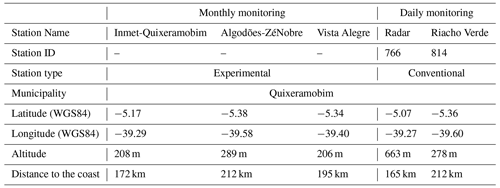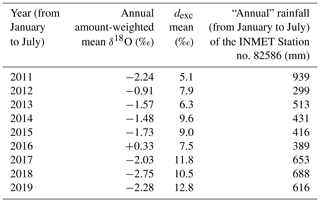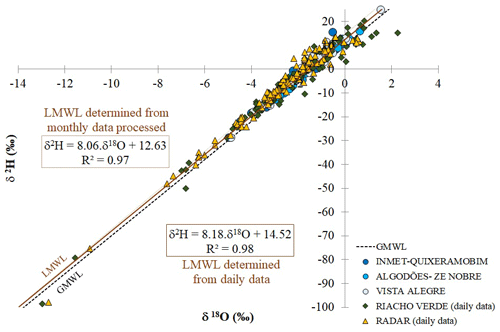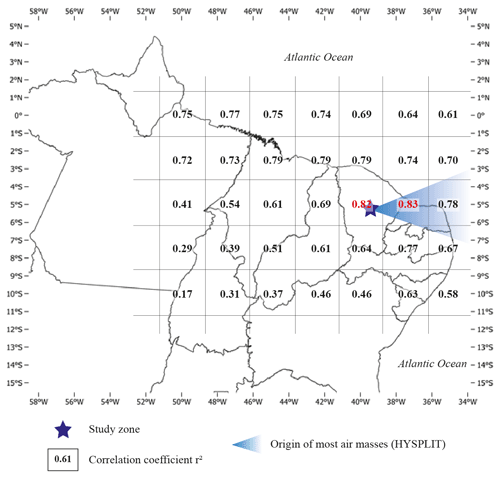the Creative Commons Attribution 4.0 License.
the Creative Commons Attribution 4.0 License.
Isotopic signature of precipitation in the semi-arid region of Ceará, Northeastern Brazil
Marjorie B. Kreis
Jean-Denis Taupin
Nicolas Patris
Eduardo S. P. R. Martins
The study of stable isotopes in the precipitation of Ceará was conducted on monthly rainfall samples between 2011 and 2019 and on daily rainfall samples between 2018 and 2019 in order to support the global knowledge of hydrological processes in semi-arid regions given the scarcity of such data in the Northeast of Brazil. Results showed that the frequency of rainfall sampling in semi-arid regions may induce an isotopic bias, due to the partial evaporation from the water collectors during monthly storage causing isotopic fractionation. In the absence of adequate data processing, this bias may lead to a wrong definition of the Local Meteoric Water Line (LMWL), which can have major consequences on the understanding of groundwater recharge processes. The processing of the monthly isotopic data (elimination of the evaporated data) and the analysis of daily data highlighted that the LMWL of Quixeramobim is characterized by a y-intercept value greater than +12 ‰, indicating that rainwater is composed of vapours from marine origin, but also from continental recycling. Analysis of δ18O monthly variations in relation to climatic factors suggested the importance of convective systems and relative humidity in the control of the isotopic composition of precipitation in a semi-arid tropical region.
- Article
(1419 KB) - Full-text XML
- BibTeX
- EndNote
SGD 6; new monitoring
The study of the stable isotopic composition of precipitation is an important tool for characterizing the groundwater input signal (Terzer et al., 2013; Gastmans et al., 2017). Indeed, the content analysis of stable isotopes (18O, 2H) in the different compartments of the water cycle and the construction of local isotopic “meteoric water lines” constitute a powerful integrative approach to understand the origin and organization of groundwater flows within aquifers, and to identify potential relationships between surface water and groundwater (Sukhija et al., 2006; Terzer et al., 2013; Santoni et al., 2016; Hao et al., 2018; Ahmed et al., 2019; Babaye et al., 2019). Moreover, stable isotopes in precipitation provide elements for understanding climatic factors that affect the precipitation regimes (Gastmans et al., 2017). To date, the isotopic characterization of rainwater in the semiarid region of Northeastern Brazil was only addressed by a few studies (Gastmans et al., 2021). Moreover, the isotopic precipitation data available were mainly linked to the establishment of the Global Network of Isotopes in Precipitation (GNIP), which started in the 1960s and was paralyzed in the 1990s for several reasons, despite the extensive use of these data to understand the hydrological processes and to identify the mechanisms of recharge and salinization in Northeastern aquifers (Gastmans et al., 2021). This study aims, therefore, to improve and update the characterization of the isotopic signal of rainfall in the semiarid region of Ceará in order to support the understanding of rainfall isotope variability and aquifer systems functioning in semi-arid regions.
The study zone is located at approximately 180 km from the Atlantic Ocean coast, in the rural municipality of Quixeramobim (5°11′40′′ S, 39°18′42′′ W), in the state of Ceará in Northeastern Brazil. The local biome is caatinga. The climate of the study area is semi-arid and characterized by an irregular distribution of rainfall, high evapotranspiration (ET) rates and recurring periods of drought (Burte, 2008; Martins and Júnior, 2017; Pontes Filho et al., 2020). The wet season extends from December to July, but almost 75 % of the precipitation is concentrated in four months of the year, from February to May. These four rainy months are related to the influence of the Inter-Tropical Convergence Zone (ITCZ), where the northeast and southeast trades flow together. The ITCZ, in the north of the northeast of Brazil, is characterised by strong upward motion and heavy rainfall (FUNCEME, 2018). The mean annual rainfall in Quixeramobim, calculated from the Thiessen polygon method for the 1961–2021 period, is around 709 mm, with values ranging from 218 to 1432 mm. For the same period, the mean annual potential evapotranspiration (PET) is around 1775 mm, which leads to a high annual water deficit (> 1000 mm yr−1). In Quixeramobim, the last important drought dates from 2012–2019, with the 2012–2016 period corresponding to the most severe 5-year drought recorded in the systematic record (40 % decrease in annual rainfall). The temperature of the study area has low thermal amplitude, with monthly mean temperatures ranging between 25.7 and 28.5 °C and an annual mean of 27.2 °C. The relative humidity presents an annual average of 61.0 %, with monthly mean values varying from 41.6 % in July to 85.9 % in February (data from INMET Station no. 82586).
3.1 Rainwater sampling
A monthly monitoring of the stable isotope composition of rainwater was operated in Quixeramobim between January 2011 and July 2019 from three experimental rainfall stations (Inmet-Quixeramobim, Algodões-ZéNobre and Vista Alegre stations), amounting to a total of 172 samples. This monthly sampling was performed on the 1st day of the month (±48 h) between January and July (period concentrating 95 % of precipitation). Moreover, a daily monitoring of the isotopic composition of rainwater was implemented in the study region, between March 2018 and October 2019, from two conventional rainfall stations (Radar and Riacho Verde stations). Daily sampling was carried out every day of the year around 07:00 local time (UTC−3), for rainfall events greater than 1 mm d−1, accumulating a total of 212 samples. The water collector of the rainfall stations was stored inside an isothermal box given the impossibility of burying the collection system. Furthermore, they were lined with aluminum foil to minimize the effects of evaporation, especially during the monthly storage. Coordinates and supplementary information of the five rainfall stations are given in Table 1.
3.2 Water stable isotopes analyses
Rainwater samples were taken from the water collector and packaged in 20 ml transparent plastic bottles. Bottles were hermetically sealed and stored in a refrigerator until transport to the laboratory. Water stable isotopes (18O, 2H) were measured on an Isoprime mass spectrometer at the LAMA laboratory of Hydrosciences Montpellier in France. Oxygen-18 composition was measured with the conventional CO2-H2O equilibrium dual inlet technique, with a precision of ±0.08 ‰. Hydrogen-2 was measured by a continuous flow method after reduction of water on Cr powder at 1050 °C, with a precision of ±0.8 ‰. Results are expressed in δ (‰) on the V-SMOW scale. Deuterium excess (dexc) was calculated according to the Dansgaard definition ().
4.1 Determination of rainfall characteristic isotopic values
4.1.1 Daily timescale
Rainwater samples taken from the daily monitoring over the 2018-2019 period in Quixeramobim showed δ18O and δ2H median values of −2.06 ‰ and −3.3 ‰, respectively. As in other dry tropical regions with strong seasonal contrasts (Taupin et al., 1997), the daily monitoring revealed an important variability of the isotopic composition of rainfall with values ranging from −12.97 ‰ to +2.27 ‰ for δ18O and from −98.5 ‰ to +20.2 ‰ for δ2H. The most depleted isotopic values (with δ18O < −10.92 ‰) were found in April 2018 on the two rainfall stations (Radar and Riacho Verde) and correspond to the last 2 d of a heavy precipitation event (4 to 5 consecutive rainy days accumulating a total of ≈ 12 % of annual rainfall, with 50 mm of rain on the penultimate day). Deuterium excess (dexc) calculated from this dataset evidenced values ranging from −2.9 ‰ to +22.1 ‰ with a median value of +13.7 ‰. Only 13 % of the dataset showed evaporated values, with dexc < +10 ‰, corresponding to minor rainfall events (< 10 mm) and an undersaturation of the atmosphere.
4.1.2 Monthly timescale
Analysis of the 172 samples of the monthly monitoring in the classical plot of δ18O vs. δ2H showed a highly evaporated isotopic line compared to the Global Meteoric Water Line (GMWL), with a line slope of 6.41 (r2 = 0.90). Furthermore, more than 51 % of the data show dexc values of less than +10 ‰ regardless of the amount of monthly precipitation (dexc median value of +9.8 ‰). In order to determine whether the evaporated samples of the monthly monitoring are due to partial evaporation of the droplets during rainfall or to evaporation problems during monthly water storage, the δ18O values of the monthly samples were compared to the monthly isotopic signal calculated by weighting the daily δ18O by precipitation. The comparison of the isotopic data was made for a same period (2018–2019) and between two stations with similar characteristics in terms of distance from the coast and altitude (Algodões-ZéNobre and Riacho Verde stations). This comparison highlighted that the data from the monthly monitoring present values generally more enriched and evaporated compared to the monthly amount-weighted data from the daily monitoring (Fig. 1). This means that the evaporated values of the monthly samples (with dexc < +10 ‰) are not only related to partial evaporation of precipitating water droplets, but to an evaporation phenomenon causing isotopic fractionation in the water collector during monthly storage. The demonstration of this isotopic bias in the monthly data is something that could change the fundamental understanding of crystalline aquifer recharge processes in Ceará and NEB, since shallow groundwater generally reflects the long-term amount-weighted mean isotopic composition of precipitation (Chang et al., 2020) and that the majority of isotopic studies in NEB are made from monthly data. Despite the existence of this isotopic bias, the relative variations of the monthly monitoring are consistent with those of the daily monitoring (Fig. 1). On a monthly scale, the data from the daily monitoring in Quixeramobim highlighted the seasonal variability of isotopic composition of precipitation, with monthly concentrations more depleted during the wettest months (from February to May, Fig. 1), as it was evidenced in Fortaleza (Da Silva Nobre et al., 2019).
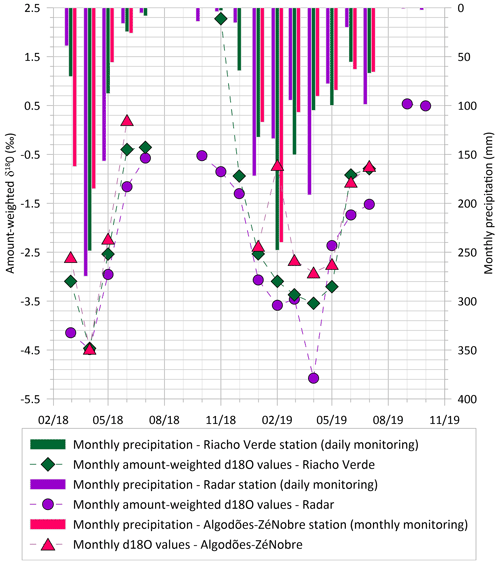
Figure 1Seasonal variability of monthly isotopic composition of precipitation obtained from the daily monitoring for the 2018–2019 period and comparison with the isotopic data obtained from the monthly monitoring network (Algodões-ZéNobre station). Monthly means of daily δ18O values are weighted by the amount of precipitation.
4.1.3 Annual timescale
The amount-weighted annual mean isotopic composition of precipitation, determined from daily data that does not exhibit isotopic bias, is −3.21 ‰ for δ18O and −12.0 ‰ for δ2H (n = 212). More depleted values (0.45 ‰ < Δδ18O < 0.58 ‰) are observed on the Radar station compared to the Riacho Verde station (Table 2). This depletion of heavy isotopes may be mostly linked to the elevation difference between the two stations (the other environmental parameters being approximately similar for both stations on the annual scale). There is a certain interannual variability of the rainfall isotopic signal. Indeed, the 2011–2019 monthly monitoring evidenced enriched amount-weighted annual isotopic values during the 2012–2016 drought compared to the other years (Table 3).
4.2 Definition of the Local Meteoric Water Line
The presence of an isotopic bias in the samples of the monthly monitoring required the processing of the data before correctly calculating the LMWL. Therefore, all the data with dexc < +10 ‰ were deleted from the monthly database (51 % of the data). Then, the plotting of the monthly isotopic data between 2011 and 2019 on a δ18O vs. δ2H graph (Fig. 2) allowed to obtain a preliminary LMWL of Quixeramobim, characterized by the following equation Eq. (1):
Evaporated samples from the daily monitoring (13 % of the data) were also not included in the construction of the LMWL. Then, the preliminary LMWL of Quixeramobim, obtained from the daily monitoring realized between March 2018 and October 2019 (Fig. 2), is defined by the following equation Eq. (2):
The slope of the LMWL of Quixeramobim of both Eqs. (1) and (2) is consistent with that of the GMWL. However, the y-intercept value is greater than +12 ‰ in both datasets despite the proximity of the study zone to the Atlantic coast. Nonetheless, data obtained in the study region from the unevaporated precipitation record available in Moura (2013) or in the IAEA-GNIP data of Fortaleza (Ceará, Brazil) also showed a y-intercept value > 10 ‰, of respectively +12.3 ‰ (r2 = 98 %, n = 8, 2011–2012 period) and +12.7 ‰ (r2 = 97 %, n = 50, 1965–1984 period). Moreover, the isotopic monitoring of daily rainfall highlighted the high d-excess values observed in the rainwater (between +10.1 ‰ and +22.1 ‰ for the non-evaporated data) and allowed, therefore, to confirm the LMWL derived from the monthly data. Consequently, the high y-intercept value of the LWML of Quixeramobim indicates that rainwater is composed of moisture from marine origin (from the Atlantic, considering the proximity of the study zone to the coast), but also from continental recycling. As a consequence, d-excess value < +12 ‰ in groundwater evidences the presence of water that has undergone evaporation, and could reveal indirect infiltration processes. This observation has major consequences in the understanding of aquifer recharge processes in NEB.
4.3 Influence of local or regional parameters
The study of the temporal variability of the rainfall isotopic composition at the daily scale showed that the isotopic signal of the Quixeramobim's precipitation is not related to the local parameters, such as the relative humidity (r2 < 0.4), the temperature (r2 < 0.2) or the rainfall amount (r2 < 0.1). Nonetheless, at the monthly scale (obtained from the daily monitoring), better correlations are found with the relative humidity (r2 < 0.8) and the rainfall amount (r2 < 0.6). In terms of regional parameters, the simulation over the year 2019 of the origin of air masses at the daily scale (47 events), tracked using HYSPLIT at several altitudes (1000, 3000 or 5000 m) over 6 last days (2500 to 4000 km before reaching the isotopic station), highlighted that most of vapours originate from the Atlantic Ocean at the East of the study zone between 5° N and 15° S (33 events). Therefore, variations in the isotopic composition of precipitation cannot be explained by changes in the moisture origin. However, the convective activity of the study region could be partly responsible for the monthly isotopic variations, considering the good correlation between δ18O and the Outgoing Longwave Radiation (OLR) data (r2 < 0.8; Fig. 3). OLR define also the main moisture direction with higher correlations at the east of the study zone highlighted with retro trajectories from HYSPLIT.
This isotopic study, based on the analysis of monthly rainfall samples between 2011 and 2019 (172 samples) and daily rainfall samples between 2018 and 2019 (212 samples), allowed to improve the characterization of the isotopic signal of precipitation in the semiarid region of Ceará. Results highlighted an important variability of the δ18O and δ2H values with daily values ranging from −12.97 ‰ to +2.27 ‰ and from −98.5 ‰ to +20,2 ‰ respectively. The annual amount-weighted mean isotopic composition of precipitation is −3.21 ‰ for δ18O and −12.0 ‰ for δ2H. However, a seasonal variability of the isotopic composition of precipitation was observed at the monthly scale, with monthly heavy isotope concentrations more depleted during the rainiest months (from February to May). Comparisons between monthly and daily data pointed out that the frequency of rainfall sampling may induce an isotopic bias and lead to a wrong definition of the LMWL in the absence of adequate data processing, which could affect the understanding of aquifer recharge processes. In this study, the selection of non-evaporated isotopic data allowed to define the preliminary LMWL of Quixeramobim by the equation δ2H (‰) = 8.06 × δ18O (‰) + 12.6 (r2 = 97 %), which indicates that rainwater is not only composed of moisture from direct marine origin, but also from continental recycling despite the proximity of the study zone to the Atlantic coast. At last, analyses of the isotopic temporal variations showed that the isotopic signal of precipitation is not linked to the amount effect at the daily scale, even if a better correlation is observed at the monthly scale. Nonetheless, analyses evidenced the importance of convective systems and relative humidity in the control of the isotopic composition of the Quixeramobim's precipitation.
This study used the software HYSPLIT Atmospheric Transport and Dispersion Modeling System of the NOAA Air Resources Laboratory (https://www.ready.noaa.gov/HYSPLIT.php, last access: 26 April 2022; Stein et al., 2015) to simulate the origin of air masses.
The research data presented in this study can be found in Kreis (2021), accessible at: https://www.theses.fr/2021MONTG031 (last access: 23 May 2022). The isotopic data of Fortaleza are from the GNIP database of IAEA, and can be found in IAEA/WMO (2022; https://nucleus.iaea.org/wiser, last access: 23 May 2022, login required).
MBK carried out the investigations and interpretations of this study under the scientific supervision of JDT and ESPRM. NP performed the stable isotope analyses. MBK prepared the manuscript with contributions from all co-authors.
The contact author has declared that none of the authors has any competing interests.
Publisher’s note: Copernicus Publications remains neutral with regard to jurisdictional claims in published maps and institutional affiliations.
This article is part of the special issue “IAHS2022 – Hydrological sciences in the Anthropocene: Variability and change across space, time, extremes, and interfaces”. It is a result of the XIth Scientific Assembly of the International Association of Hydrological Sciences (IAHS 2022), Montpellier, France, 29 May–3 June 2022.
This work is part of the multidisciplinary French-Brazilian cooperation between IRD and FUNCEME. The authors gratefully acknowledge the NOAA Air Resources Laboratory (ARL) for the provision of the HYSPLIT transport and dispersion model (https://www.ready.noaa.gov, last access: 26 April 2022) used in this publication.
This research has been supported by the LAMA laboratory and the FUNCEME.
This paper was edited by Christophe Cudennec and reviewed by two anonymous referees.
Ahmed, A. A., Shabana, A. R., and Saleh, A. A.: Using hydrochemical and isotopic data to determine sources of recharge and groundwater evolution in arid region from Eastern Desert, Egypt, J. Afr. Earth Sci., 151, 36–46, https://doi.org/10.1016/j.jafrearsci.2018.11.024, 2019.
Babaye, M. S. A., Orban, P., Ousmane, B., Favreau, G., Brouyère, S., and Dassargues, A.: Characterization of recharge mechanisms in a Precambrian basement aquifer in semi-arid south-west Niger, Hydrogeol. J., 27, 475–491, https://doi.org/10.1007/s10040-018-1799-x, 2019.
Burte, J.: Os pequenos aquiferos aluviais nas areas cristalinas semi-aridas: Funcionamento e estrategias de gestao. Estudo de caso no Nordeste brasileiro, PhD Thesis, University of Montpellier, https://theses.hal.science/tel-00399714 (last access: 5 July 2021), 2008.
Chang, H. K., Gonçalves, R. D., Aggarwal, P. K., Stradioto, M. R., Hespanhol, E. C., Sturchio, N. C., and Araguas, L. J.: Groundwater isotope ratios reflect convective and stratiform (paleo) precipitation fractions in Brazil, J. Hydrol., 585, 124801, https://doi.org/10.1016/j.jhydrol.2020.124801, 2020.
Da Silva Nobre, M. E., Gomes, D. F., Vasconcelos, S. M. S., de Lima Neto, I. O., Ferreira, S. K., and de Ponti Souza, D.: Estudo hidroquímico-ambiental do aquífero aluvionar do baixo Jáguaribe, Itaiçaba–Ceará, Revista do Instituto Geológico, 39, 77–92, https://doi.org/10.33958/revig.v39i3.601, 2019.
FUNCEME: Para entender melhor a previsão climática para a estação chuvosa no Ceará e glossário de termos meteorológicos, FUNCEME, Fortaleza, 23 pp., http://www.funceme.br/?page_id=9153 (last access: 5 July 2021), 2018.
Gastmans, D., Santos, V., Galhardi, J. A., Gromboni, J. F., Batista, L. V., Miotlinski, K., and Govone, J. S.: Controls over spatial and seasonal variations on isotopic composition of the precipitation along the central and eastern portion of Brazil, Isot. Environ. Healt. S., 53, 518–538, https://doi.org/10.1080/10256016.2017.1305376, 2017.
Gastmans, D., Garpelli, L. N., dos Santos, V., de Lima, C., Quaggio, C. S., Santarosa, L. V., and Kirchheim, R. E.: Contribuição dos isótopos estáveis da água (H e O) no conhecimento dos aquíferos brasileiros: estado da arte e perspectivas futuras, Derbyana, 42, https://doi.org/10.14295/derb.v42.734, 2021.
Hao, S., Li, F., Li, Y., Gu, C., Zhang, Q., Qiao, Y., and Zhu, N.: Stable isotope evidence for identifying the recharge mechanisms of precipitation, surface water, and groundwater in the Ebinur Lake basin, Sci. Total Environ., 657, 1041–1050, https://doi.org/10.1016/j.scitotenv.2018.12.102, 2018.
IAEA/WMO: Global Network of Isotopes in Precipitation, The GNIP Database, https://nucleus.iaea.org/wiser, last access: 23 May 2022.
Kreis, M.: Origine et dynamique de salinité des aquifères fracturés cristallins de la région semi-aride du Ceará, Brésil, PhD Thesis, University of Montpellier, Federal University of Ceará, NNT: 2021MONTG03, https://www.theses.fr/2021MONTG031 (last access: 23 May 2022), 2021.
Kreis, M., Taupin, J. D., Patris, N., and Martins, E. S. P. R.: Isotopic characterisation and dating of groundwater recharge mechanisms in crystalline fractured aquifers: example of the semi-arid Banabuiú watershed (Brazil), Isot. Environ. Healt. S., 56, 418–430, https://doi.org/10.1080/10256016.2020.1797275, 2020.
Martins, E. S. P. R. and Júnior, F. D. C. V.: O clima da Região Nordeste entre 2009 e 2017: Monitoramento e previsão, Parcerias Estratégicas, 22, 63–79, 2017.
Moura, I. B. M. D.: Estudos das águas da bacia hidrográfica do Rio Banabuiú no trecho entre Quixeramobim e Banabuiú, Ceará, Brasil, PhD Thesis, Federal university of Fortaleza, https://rigeo.cprm.gov.br/handle/doc/1188 (last access: 5 July 2021), 2013.
Pontes Filho, J. D., Souza Filho, F. D. A., Martins, E. S. P. R., and Studart, T. M. D. C.: CopulaBased Multivariate Frequency Analysis of the 2012–2018 Drought in Northeast Brazil, Water, 12, 834, https://doi.org/10.3390/w12030834, 2020.
Santoni, S., Huneau, F., Garel, E., Vergnaud-Ayraud, V., Labasque, T., Aquilina, L., and Celle-Jeanton, H.: Residence time, mineralization processes and groundwater origin within a carbonate coastal aquifer with a thick unsaturated zone, J. Hydrol., 540, 50–63, https://doi.org/10.1016/j.jhydrol.2016.06.001, 2016.
Stein, A. F., Draxler, R. R., Rolph, G. D., Stunder, B. J. B., Cohen, M. D., and Ngan, F.: NOAA's HYSPLIT Atmospheric Transport and Dispersion Modeling System, B. Am. Meteorol. Soc., 96, 2059–2077, https://doi.org/10.1175/BAMS-D-14-00110.1, 2015 (code available at: https://www.ready.noaa.gov/HYSPLIT.php, last access: 26 April 2022).
Sukhija, B. S., Reddy, D. V., Nagabhushanam, P., Bhattacharya, S. K., Jani, R. A., and Kumar, D.: Characterisation of recharge processes and groundwater flow mechanisms in weathered-fractured granites of Hyderabad (India) using isotopes, Hydrogeol. J., 14, 663–674, https://doi.org/10.1007/s10040-005-0461-6, 2006.
Taupin, J. D., Gallaire, R., and Arnaud, Y.: Analyses isotopiques et chimiques des précipitations sahéliennes de la région de Niamey au Niger: implications, IAHS-AISH P., 244, 151–162, https://www.documentation.ird.fr/hor/fdi:010015696 (last access: 5 July 2021), 1997.
Terzer, S., Wassenaar, L. I., Araguás-Araguás, L. J., and Aggarwal, P. K.: Global isoscapes for δ18O and δ2H in precipitation: improved prediction using regionalized climatic regression models, Hydrol. Earth Syst. Sci., 17, 4713–4728, https://doi.org/10.5194/hess-17-4713-2013, 2013.






